Places To Visit In Goa
Tiracol Fort

Positioned at the mouth of Terekhol River, in the northernmost part of Goa, 'Tiracol Fort' or 'Terekhol Fort' is situated about 42 kilometers from Panaji. The name 'Terekhol' is supposed to have derived from Marathi language where 'Tir Khol' means, steep river bank. Originally this fort was built in 17th century by Maharaja Khem Sawant Bhonsle of Sawantwadi. The main purpose behind it was to get a commanding view of the Arabian Sea and also keep an eye over the naval traffic in the Terekhol River.
In 18th century (1746), Tiracol Fort was taken over by Portuguese and remained under their control till 1961. The fort has also played an important role in the Portuguese Civil War. The fort today stands in the memory of those innumerable freedom fighters who laid down their lives in order to acquire Independence for our country. A church for holy Trinity was constructed inside the Tiracol Fort which today is famous as the Church of St. Anthony. This church is not generally opened for public except on the day of annual feast.
Tiracol Fort can be reached by a car ferry from Querim or by a ferry from the Keri beach. Today this fort is converted to a heritage hotel that caters the services to the tourists.
Chapora Fort
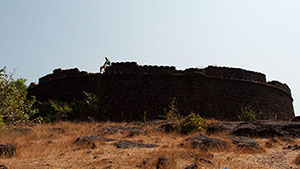
The place where the Chapora Fort is standing today, there stood an olden fort built by Shah Adil of Bijapur on the banks of Chapora River. The original fort dates back to the time long before the Portuguese arrival at Goa. Chapora Fort was one of the most sought after forts and it passed from hand to hand several times. Even Akbar joined hands with Marathas against Portuguese and at that time, this fort served as his base camp. The present Chapora Fort was constructed in the year 1717 by Portuguese by demolishing an earlier watch post.
Situated about 10 km from Mapusa on the southern highland of the river Chapora, this fort haughtily overlooks the Vagator Beach and guards the Chapora Estuary. The outline of steep slopes helps the fort to be naturally defensive. A number of Bollywood films, 'Dil Chahta Hai' being the most prominent, have used the Chapora Fort as a backdrop to their shooting. The spectacular vista of the surrounding beaches perceived from this fort turns out to be an additional dimension to the visit to this historical relic.
Fort Aguada
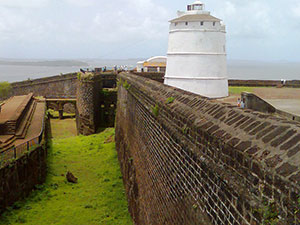
Situated on the Sinquerim Beach, overlooking the Arabian Sea approximately 12 kilometers from the state capital Panjim, the Fort Aguada holds the honor to be the first line of defense during the Portuguese dominion in Goa. This fort was established in the year 1612 by Portuguese in order to protect old Goa against the foreign invasions of Dutch and the Maratha forces via Mandovi River. The Aguada fort is so large that it encompasses the entire peninsula near the south western tip of Bardez. The Aguada Fort is well equipped with barracks and ammunition rooms. The fort has witnessed a number of sanguinary events through centuries.
A spring of fresh water inside the fort provided water supply to the sailors who used to stop by. This is the reason why the fort got its name: Aguada. Aguada means water.
The first ever made lighthouse in Asia is situated at The Aguada Fort. This is a four storied structure built in the year 1864. This lighthouse was once used as a grandstand of 79 cannons. Presently the fort serves as the Central Jail of Goa State. Once upon a time, this fort was embellished with a unique tower bell, which happened to be the central attraction of this place. Today, this bell has been removed from the fort and is placed at the Church of 'Lady of Immaculate Conception' where it augments the spiritual charm of the holy church.
Olive Ridley Turtles

If you want to witness a rare event of natural breeding of turtles, you must visit The Morjim Beach in northern Goa. The Morjim Beach has been selected by the 'Olive Ridlety turtles' as their breeding grounds. 'Olive Ridlety' turtles, also called 'the Pacific Ridlety' are classified under vulnerable species of turtles by the International Union for Conservation of Nature and Natural Resources (IUCN). The Morjim Beach is overcrowded with innumerable turtles hatching their eggs during their breeding season, i.e. November to march.
Church of Reis Magos

Located just next to the famous Napier Museum and about 2 km from the Situated on the northern banks of Mandovi Bardez River at Verem village near Panjim, The Church of Reis Magos was built in the year 1555 in the holy memoir of Three Magic Kings. Constructed by Franciscan missionaries, this church is dedicated to St. Jerome. The church boasts of a long historical background. The Church of Reis Magos has provided shelter to all the major celebrities from the well known Franciscan order and has also hosted various missions undertaken by those dignitaries. The Feast of Reis Magos is celebrated on 6th January every year. This feast is considered to be very sacred and myriads of devotees across the Mandovi River arrive here to attend the feast.
The architecture of the Church presents a fine amalgamation of Hindu and Christian style and culture. For example, the steps of the church are decorated with lions and the altar displays the three Magi paying tribute to the New Born Jesus. The church offers a mesmerizing view of emerald green sea and shiny silvery beaches.
Bishop's Palace
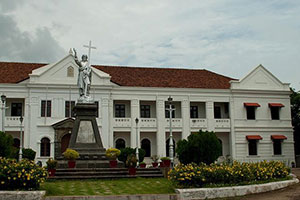
'The Bishop's palace', also known as 'The Patriarchal Palace' is situated at Altinho of Panjim. Constructed over a hillock surveying the entire city of Panjim, this mighty and imposing residence of the Archbishop of Goa was set up in 1894 AD. The Bishop's Palace was built in order to reflect the elevation of the Archbishop to a Patriarch. The Goa diocese was established at Altinho in 1533 AD. In the year 1557, the diocese was elevated to the status of an Archdiocese. In 1886, the development of this area began and Archbishop was again raised to the Patriarchal status. 'Dom Antonio Sebastiao Valente' was the first Patriarch here whose portrait is designed at the entrance now. The archbishop arrived to dwell in Panjim in the 20th century Altinho has become the most prestigious places in Goa to stay at. the Pope stayed at this mansion during his visit to Goa in the year 1999.The Bishop's Palace is a must visit place for the devotees, particularly during Christmas season.
Church of Holy Spirit
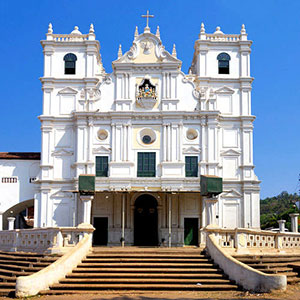
The Church of Holy Spirit or 'Largo de Igreja' is located in the old market square opposite Fort Naroa in North Divar, at Margao, Goa. A Hindu Temple dedicated to Lord Damodar was demolished in the year 1564. The Church of Holy Spirit was erected at the very place in 1565 by a Jesuit Friar Antonio de Quadros. The original church was also destroyed in 1571 and what we have today was later constructed in the year 1675. The work had begun in 1645 but it took almost 30 years to complete the construction.
Fashioned after the Basilica de Bom Jesus, this church exhibits a fine example of Indian Baroque style. The outer frontage of the church comprises a pristine white fa'ade and a central dome structure with towers on either side. This structure clearly exhibits the effect of Indian architectural style on it. The interior of the church dripping with gilt crystal and stucco is peerlessly beautiful and sublime in style.
The ornamental altar of the church is heavily decorated and holds a gilded and carved archway. It is dedicated to Mother Mary, St Peter and St. Michael. The intricate architectural style of the church is a real feast for the eyes. Presently about 2900 Catholic families belong to this church.
Cabo da Rama Fort
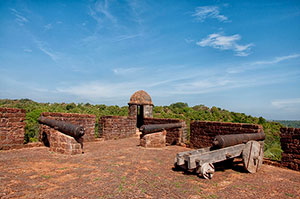
Constructed by the great Maratha King Chhtrapati Shivaji Maharaj in 1679, this fort is situated about 30 kilometers from Margao at Canacona, the southernmost Taluk of Goa. Cabo da Rama Fort, also known as 'Cape Rama Fort' is spread over the area of 179600 sq. meters and is regarded to be the biggest fort in Goa. This fort, dated back to the pre- Portuguese period was reined by the Kings of Sundem until 1763 when it was conquered by Portuguese. As the fort is named after the Hindu God 'Lord Rama', it is believed that Lord Rama resided here during the period of his exile. The fort, built in Laterite, houses a church (St Antonio Church) which is dated back to the Portuguese era. This church remains intact even today.
During the British Colonization, Cabo da Rama fort was used as a prison for 25 years from 1932 to 1957. Today the ruins of this fort are preserving the historical and cultural relics of the past. From the west side of the fort we get panoramic views of the endless sea and deep cliffs. State transport buses are available from Margao to reach Cabo da Rama fort or one can rent a taxi from anywhere in Goa.
Basilica de Bom Jesus
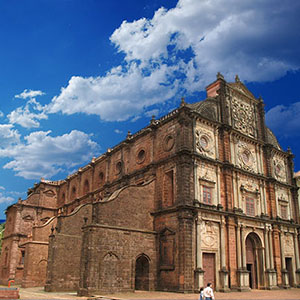
'Basilica de Bom Jesus', also renowned as 'Basilica of Good Jesus', is deemed by UNESCO as a World Heritage Site. The word 'Bom' means 'God Jesus' or 'Infant Jesus'. Being the first minor basilica in India named after infant Jesus, this church is amongst the most prominent attractions of Goa. Situated in Old Goa about 9 km from Panaji, Basilica de Bom Jesus depicts the best example of Baroque style of architecture. Constructed in the year 1605, this cathedral, apart from the baroque style, also presents a typical Renaissance architectural pattern and the Portuguese manner.
The site where the church is standing today was originally the base of a Lord Shiva Temple. Some extremist Portuguese rulers demolished the temple and decided to construct a church there. The work started in the year 1594 and the construction was completed in May 1605. Basilica de Bom Jesus is acclaimed far and wide for housing the mortal remains of St. Francis Xavier, a prolific missionary, the co-founder of 'The Society of Jesus' along with St. Ignatius Loyola and the patron saint of Goa.
The sacred body of St. Xavier is preserved in an airtight glass coffin which is placed in a silver casket. This casket was designed by a 17th century Florentine sculptor named Giovanni Batista Foggini. The miraculous body of the saint is in a very good condition even after more than 400 years of his demise. The mystery behind this is still not unraveled and there are no logical reasons that can explain the science behind this rare phenomenon.
The dead body of St. Xavier is held for public viewing once in every 10 years. Last time the body was displayed for the 'Darshana' in 2004. Thousands of devotees arrive to get a glimpse and pay homage at the time of public exposition of the body. It is believed that all your wishes come true if you take the Darshana of the auspicious body. Light and sound show depicting the birth and life of Jesus, St, Francis Xavier and Blessed Joseph Vaz is organized at the church premises that interest and entertain the tourists to no extent.
Church of St.Francis of Assisi
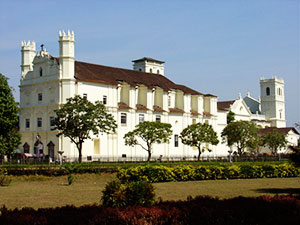
Originally established by the famous eight Franciscan friars in the year 1517, 'The Church of St. Francis Assisi' is Located about 9 kilometers from Panaji in Old Goa, just opposite the world famous 'Basilica de Bom Jesus'. The construction of the church was completed in 1521 and it was sanctified to the Holy Ghost. Later the Church was demolished and what we have today was built in 1661 at the same site sharing the campus with Se Cathedral. An educational institute was also run within the church but it was closed down by the Portuguese government in 1835.
The noteworthy feature of this church is its architecture that presents a fine blend of Christian style with Hindu bearing. The exterior of the church manifests Tuscan architecture while the interior exhibits the Mosaic-Corinthian style. The outer walls are decorated with frescoes displaying intricate floral designs and the scenes from the Bible adorn the interior walls. Baroque and Manuline style interiors, inscribed tombstones, gilded altar, exquisitely carved old gate made of black stone add to the architectonic artistry of the church. The paintings showcased in the church have a very distinctive Indian feel. Sculptures, relics and paintings of several Hindu temples of Goa are also exhibited here.
A big statue of St. Michael is placed at the entrance of the church and two large statues of Jesus Christ and St. Francis of Assisi are seen in the heavily decorated congregation hall. The Archaeological Survey of India has converted this church into a museum from 1964 which boasts of a wide collection choicest sculptures, artifacts and paintings. The Church of St. Francis Assisi is a must visit place in Goa both for the devotees as well as those who love and has a taste in art and culture.
Se Cathedral
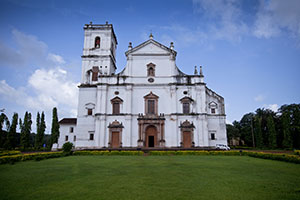
Situated right on the banks of the river Mandovi, adjacent to the Church of St. Francis Assisi and 'Basilica de Bom Jesus', about 9 kilometers from Panaji, the 'Se Cathedral' is well known for its mighty stature. 'Se Cathedral', also called 'St. Catherine's Church' is larger in dimension and structure as compared to any other Church in India. It took more than 62 years to complete this imposing edifice. This church is dedicated to St Catherine of Alexandria who constantly blesses the Portuguese army. A mosque was positioned at this site earlier which was demolished and the Se cathedral was set up at the very grounds.
The exteriors of this church demonstrate half-Tuscan and half-Doric architectural styles. The interior of the cathedral is adorned in Mosiac-Cornithian architecture. The north tower of the cathedral was struck by the lightning in 1776 which caused its fall. The tower is not rebuilt yet. But, the south tower stands still wearing the famous 'Golden Bell' that manifests the riches of Se cathedral.
Shri Mangeshi Temple
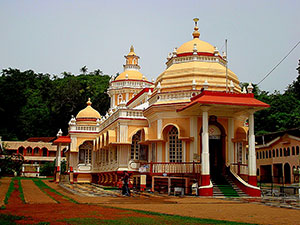
Located at Priol about 22 kilometers from Panaji and 26 kilometers from Margao, Shri Mangeshi Temple is dedicated to Lord Mangesh: the patron deity of Goa. Lord Mangesh is believed to be the incarnation of Lord Shiva. The original Mangeshi Temple was situated at Kushasthali (Cortalim) but it was later shifted to Pirolim or Priol under the fear that Portuguese forces might destroy it. At that time Priol belonged to the dominion of Adil Shah of Bijapur. As a result of shifting process, the temple had to experience a number of repairs.
The architecture of Shri Mangeshi Temple suggests the profound influence of Portuguese and Mughal style over the Hindu manner. The doomed tops of the temple reflect a distinct Muslim influence and the tower built above the sanctum in octagonal shape and the design of balustrade indicate a Christian interference. The temple placed on the wheels and adorned by bright paints fascinates the tourists as soon as they enter the premises. At the time of the annual festival of this temple, the idol of Lord Mangesh is placed in a chariot and is carried in a procession.
Shantadurga Temple
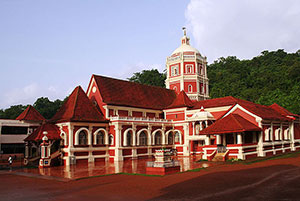
Established by Chatrapati Shahu Maharaja of Satara in the year 1738, the Shantadurga Temple is an important Hindu pilgrim destination in Goa. Situated approximately 33 kilometers from Panaji at Kavlem village in Phonda taluk, this temple is dedicated to Goddess Shantadurga, the incarnation of Goddess Parvati who mediated between Lord Shiva and Lord Vishnu. Also known amongst the natives by the name 'Santeri', this Goddess is the Kuldevi of many Konkani families.
The original temple of Shantadurga was situated at Cavellossim (Quelshim) in Salsette which was destroyed by Portuguese forces in 1564 AD. As a result, the deity was shifted to Kavlem and Chatrapati Shahu Maharaja built this new temple. The goddess seated in the sanatorium is adjoined by Lord Shiva on one side and Lord Vishnu on the other. The temple complex perched at the foothills of a mountain range is surrounded by lush green vegetation. The main temple where Goddess Shantadurga is seated is accompanied by three smaller temples dedicated to various Hindu deities.
The roofs of these temples are designed in a pyramid shape. The pillars and the floors of the temples are made of Kashmir stone. A huge tank, Agrashalas and a five storied Dipa Stambha are the prominent features of this temple. The interior of the temple is decorated with beautiful engravings and the artfully designed silver work is protected with the help of marble and glass chandeliers.
Shri Laxmi Narasimha Temple
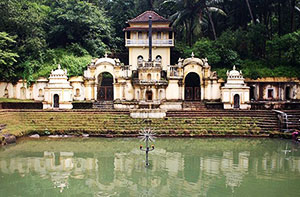
Situated at a village named Velinga approximately 3 km from Mardol in Ponda, this 18th century temple is dedicated to the 4th incarnation of Lord Vishnu i.e. Lord Narasimha and Goddess Laxmi. It is believed that the deity seated in this temple was originally placed in a temple at Salcete and later shifted to this temple in Ponda in 1567.
The Chowki or the temple hall depicts the carvings and the paintings from Sri Narasimha Purana, as well as Dashavataras (The ten incarnations of Lord Vishnu). A serene lake situated in front of the courtyard and adorned by number of coconut trees add to the beauty of the temple. People bathe in this holy tank at the time of some auspicious occasions. The major festivals celebrated at the Laxmi Narasimha Temple include the Manguirish Zatra celebrated in mid-February, Navaratri, Ramanavami, Shukla Chaturdashi etc. On the day of Shukla Chaturdashi every month, the idol of Laxmi Narasimha is seated in a palanquin and carried in a procession.
Shri Mahalsa Temple

Located at Mardol in Ponda, this temple is dedicated to Goddess Mahalsa, (Goddess Laxmi). Also known as Shri Mahalsa Narayani Temple, this shrine comprises a very important Hindu pilgrimage in Goa. Originally the Goddess Mahalsa was seated at a temple in Salcete taluk. But in 16th century the armies of Adil Shah attacked the temple and demolished it. The deity was rescued from the ruins of the temple and shifted to Mardol where the present temple was constructed.
According to another legend, the Goddess Mahalsa is the incarnation of Lord Vishnu in a female form i.e. Mohini. Lord Vishnu designed himself as Mohini to kill Bhasmasur and save the earth from being burnt into ashes by him.
The entrance of the temple is ornamented with a 21 tire lamp tower placed above Kurma (tortoise: the 2nd incarnation of Lord Vishnu). This deepstambh is made from brass and is 12.5 meters high. This lamp tower is regarded to be the world's largest Lamp tower. When all the oil lamps of this deepstambh are lighted, it creates a magnificent site.
The temple hall portrays the carvings and paintings of the Dashavataras, the ten incarnation of Lord Vishnu. The doorway to the sanctum is embellished with an elaborate silver frame. An ancient water tank is situated behind the temple. Mardol Zatra celebrated in February every year is the main festival of Shri Mahalsa Temple. Other than that, Mahashivratri and Kojagiri Purnima are also celebrated at this temple with equal zest and devotion.


